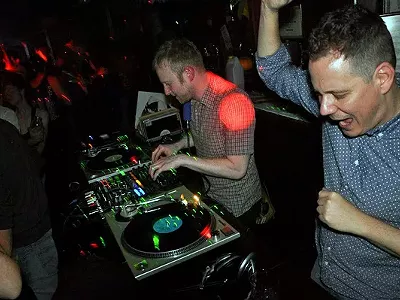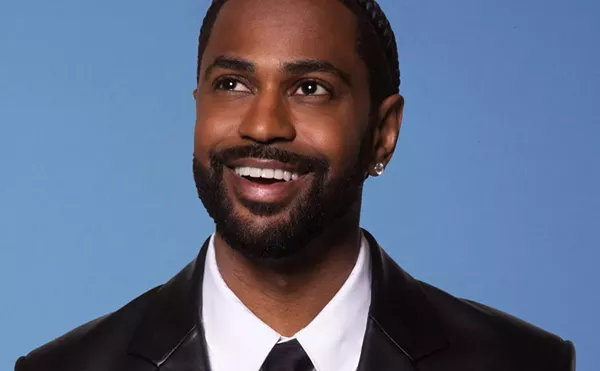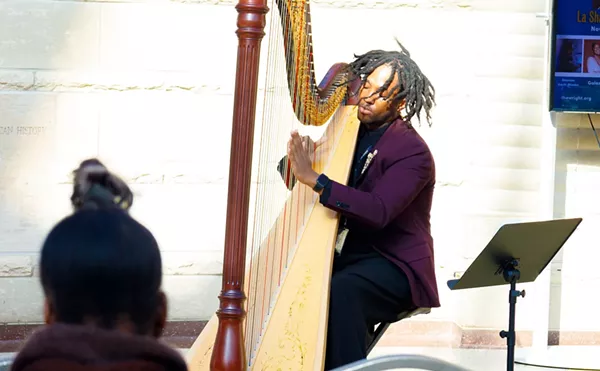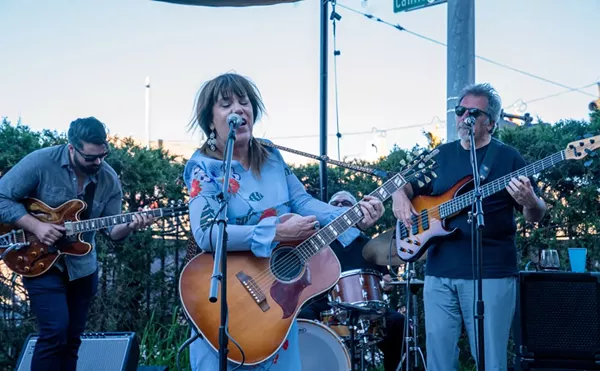Marcus Elliot arrives with Big Motifs
... and I can still feel the music in my bones.


Audio By Carbonatix
[
{
"name": "GPT - Leaderboard - Inline - Content",
"component": "35519556",
"insertPoint": "5th",
"startingPoint": "3",
"requiredCountToDisplay": "3",
"maxInsertions": 100,
"adList": [
{
"adPreset": "LeaderboardInline"
}
]
}
]
I feel like I’m still living inside the music from this live, intimate jazz concert on Wednesday.
It was a new venue for me outside of Detroit. Now, it’s a new favorite. The Blue LLama Jazz Club is a 45-minute drive from the city in Ann Arbor, home to University of Michigan. For a club that’s music first (and has spawned its own record label), the food was stunning. And that’s a good reminder that the reality for jazz clubs to stay open in 2025 is that the food and booze better be good because it’s critical to keeping the lights on.
I made the trek to see Marcus Elliot, a saxophonist, composer, and educator based in Detroit. I’ve seen him in so many contexts. I’ve walked wildly stoned into the Detroit Institute of Arts, following the sound of Elliot’s avant-garde circular breathing inside the gorgeous Rivera Court. It felt like I had won a sweepstakes to have a walk-on role in a special episode of Twin Peaks. It’s a musical moment I’ll never forget.
I’ve seen Elliot perform straight hard bop tracks in another jazz club downtown. I’ve heard him on recordings with musicians like Shigeto, who enlists Elliot to help him blur the lines between house music, jazz, and whatever else you want to call it. (The Grammys recently added a category for “alternative jazz,” so look out for that to stick over the next couple years, at least in some circles.)
That’s all to say that Elliot, for me, is one of the leading figures of Detroit’s contemporary jazz scene. A true living example of the city’s ethos towards passing the torch to the next generation. He once served as the director of the Detroit Symphony Orchestra Civic Jazz Band, which has produced nearly as much talent in Detroit as the Black church. These contributions were recognized in 2020 with a Kresge Artist Fellowship, one of the most prestigious acknowledgements of artistic excellence not just in Michigan but around the country.
At the Blue LLama, I watched Marcus Elliot perform the best concert I’ve ever seen him do.
His Big Motifs band was the largest ensemble he’s lead as bandleader on stage. It featured a stellar group of musicians including Ian Finkelstein (piano), Nate Winn (drums), Jonathan Muir-Cotton (bass), Dwight Adams (trumpet), Erinn Alexis (baritone saxophone), and Zekkereya El-Magharbel (trombone).
It had evolved into something fresh from all the other times I had seen Elliot in so many different configurations. When he called the band Big Motifs, he meant earth-shaking ones, to the point that I can still feel the music as well as hear it in my head. (Can’t say that for a lot of concerts I go to.) It was heavy on afro-beat influence, fashioned in the likes of Fela Kuti and Antibalas but still keeping close to form with the hard bop, big band sound of the 1950s and early 1960s.
Elliot was using every musical inch of his ensemble, eliminating the subtly and going big — to the delight of the audience. The amount of wooing, hollering, and the eventual standing ovation matched the energy that the band was giving back.
If you weren’t there, it’s OK. Thankfully, it was all captured for an upcoming live record of the same name — “Big Motifs” — that’ll likely be out later this year.
And when it does drop, I’ll be sure to write about the experience of reliving it all over again on vinyl for you right here. It was an experience so musically rich that we’ll all feel like we’re still in the moment with Marcus Elliot and his Big Motifs band.
Published in partnership with Midbrow.






